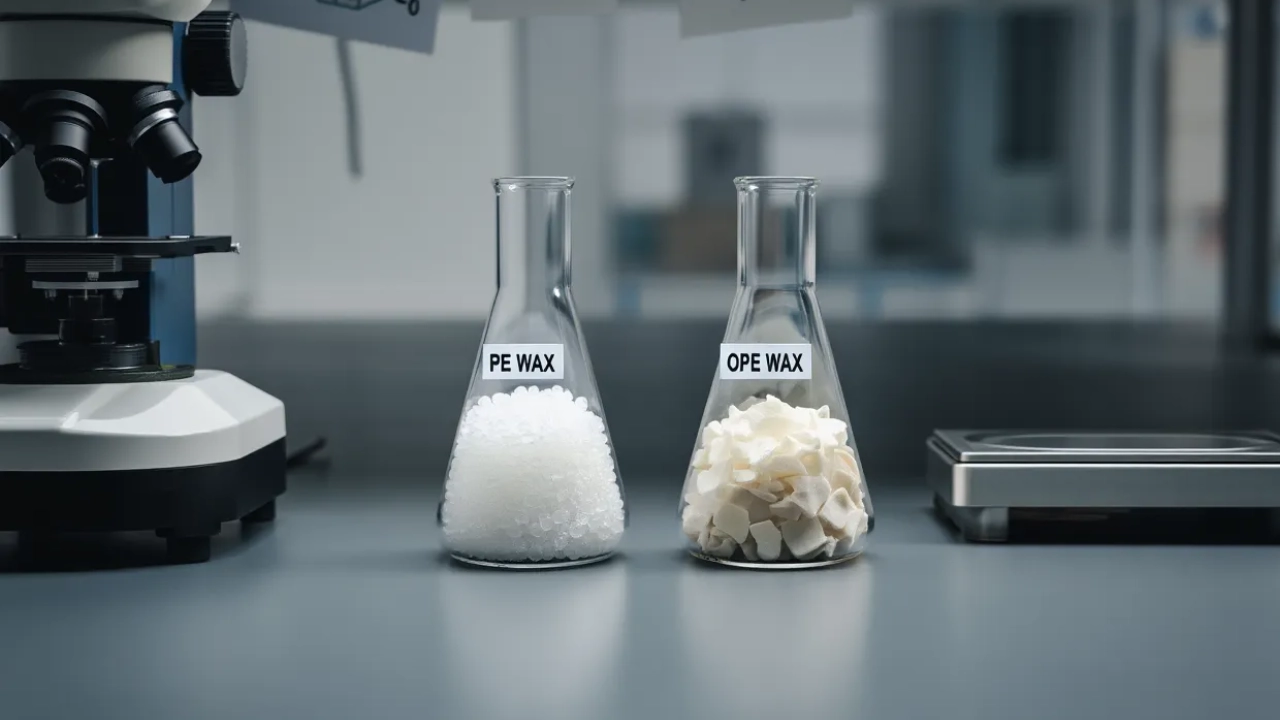PE Wax vs OPE Wax: The Definitive Guide to Differences & Applications

Introduction
In the competitive world of polymer additives, the PE Wax vs OPE Wax debate is central to formulation success. While both are essential low-molecular-weight polymers used to enhance plastics, coatings, and adhesives, their core difference lies in polarity. This fundamental distinction dictates compatibility, performance, and ultimately, which wax you should choose for your application.
This ultimate guide provides a head-to-head comparison of polyethylene wax and Oxidized Polyethylene Wax, equipping manufacturers and formulators with the knowledge to boost efficiency, drive innovation, and select the perfect additive for their needs.
What is PE Wax? (Polyethylene Wax)
PE Wax, or polyethylene wax, is a non-polar, synthetic wax produced through the polymerization of ethylene. Its straightforward long-chain hydrocarbon structure grants it excellent hydrophobicity, chemical inertness, and low viscosity when heated.
Key Characteristics of PE Wax:
-
Chemistry: Non-polar, long-chain hydrocarbons
-
Molecular Weight: 2,000–6,000 g/mol
-
Density: 0.92–0.93 g/cm³
-
Melting Point: 100–110°C
-
Key Properties: High hardness, excellent gloss, superior lubricity, and resistance to acids and alkalis.
Primarily, PE Wax acts as an exceptional lubricant and dispersant in non-polar systems.
What is OPE Wax? (Oxidized Polyethylene Wax)
OPE Wax or Oxidized Polyethylene Wax is a modified version of PE Wax that undergoes a controlled oxidation process (typically with air at ~380°C). This process introduces polar functional groups—such as carbonyls, hydroxyls, and carboxylic acids—onto the polymer chain.
Key Characteristics of OPE Wax:
-
Chemistry: Polar, with functional groups (-COOH, -OH)
-
Melting Point: 100–138°C
-
Acid Value: This is a critical metric, enabling the formation of stable emulsions.
-
Key Properties: Enhanced compatibility with polar materials, excellent emulsifiability, improved adhesion, and balanced lubrication.
Essentially, Oxidized Polyethylene Wax is the go-to choice for enhancing performance in polar systems and water-based applications.
PE Wax vs OPE Wax: A Detailed Comparison Table
This side-by-side comparison highlights the critical differences that inform your selection process.
| Feature | PE Wax | OPE Wax |
|---|---|---|
| Chemical Structure | Non-polar hydrocarbons | Polar with functional groups (e.g., -COOH, -OH) |
| Polarity | Low (Hydrophobic) | High (Hydrophilic) |
| Melting Point | 100–110°C | 100–138°C |
| Emulsifiability | Poor; not for water-based systems | Excellent; forms stable emulsions in water |
| Compatibility | Excellent with non-polar resins (PP, PE) and fillers | Superior with polar resins (PVC, Nylon), pigments, and fillers |
| Primary Function | Strong external lubricant, dispersant | Balanced internal/external lubricant, coupling agent, dispersant |
| Adhesion | Moderate | Superior, especially in polar systems |
| Stability | Excellent acid/alkali resistance | Enhanced thermal stability; non-corrosive |
Applications: How to Choose the Right Wax
Your choice between PE and OPE wax ultimately depends on the polarity of your system and the performance traits you need to achieve.
When to Use PE Wax:
PE Wax is ideal for non-polar applications where superior lubrication and water resistance are key.
-
Plastics & Rubber Processing: Acts as a lubricant in the extrusion and injection molding of polyolefins (PP, PE), reducing viscosity and preventing melt fracture.
-
Solvent-Based Coatings & Inks: Improves slip, rub, and abrasion resistance without affecting clarity.
-
Hot-Melt Adhesives: Modifies viscosity and improves open time for better wetting and application.
-
Textiles & Paper: Provides durable water repellency.
When to Use OPE Wax:
OPE Wax is the champion of polar and water-based systems, where compatibility and adhesion are paramount.
-
PVC Processing: A vital additive for rigid PVC profiles and pipes, acting as a lubricant and processing aid that enhances surface finish and thermal stability.
-
Water-Based Coatings, Inks & Polishes: Improves particle dispersion, speeds drying time, and enhances scratch and mar resistance.
-
Adhesives & Sealants: Strengthens polar bonds, improves adhesion to diverse substrates, and controls setting time.
-
Cosmetics & Textiles: Functions as an effective emulsifier and thickener in creams and lotions, and as a softener in textiles.
Frequently Asked Questions (PE Wax vs OPE Wax)
Both waxes are considered non-toxic and have similar eco-profiles. However, OPE Wax can contribute to sustainability by enabling high-performance, water-based formulations (replacing solvent-based ones) and improving pigment dispersion, which can reduce overall additive load and waste.
Typically, yes. The additional oxidation process adds a production step, making OPE Wax generally more costly than standard PE Wax. However, its superior performance in specific applications often justifies the investment through improved end-product quality and processing efficiency.
Not always. While both are lubricants, their different polarities mean they perform best in different environments. Substituting one for the other in a polar system (like PVC) or a non-polar system (like PP) can lead to incompatibility, causing hazing, poor surface quality, or reduced performance. Always test compatibility first.
OPE Wax is almost always the better choice for PVC. PVC is a polar polymer, and OPE Wax’s polar functional groups allow it to integrate and perform effectively as a lubricant and processing aid without exuding or causing defects.
Conclusion: Winning the PE Wax vs OPE Wax Decision
The choice is clear once you analyze your system’s needs:
-
Choose PE Wax for cost-effective, high-performance lubrication and release in non-polar systems like polyolefins and solvent-based products. It wins on simplicity and cost.
-
Choose OPE Wax for superior compatibility, adhesion, and dispersion in polar systems like PVC, water-based coatings, and adhesives. It wins on versatility and performance in demanding environments.
Your Next Step: For complex formulations, consider testing both waxes or using them in tandem to achieve hybrid performance benefits. Always consult the relevant Safety Data Sheets (SDS) for handling and storage information.

